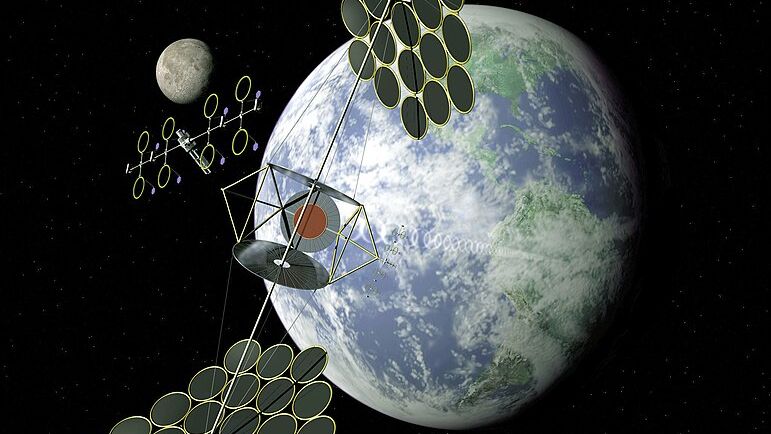Space Lasers Powered by Bacteria? Scientists Aim for a Revolutionary Energy Source
Scientists are exploring an out-of-this-world solution to the growing energy needs of satellites orbiting our planet. Imagine solar-powered lasers, fueled by the photosynthetic machinery of bacteria. This groundbreaking concept, developed by an international team of researchers for the APACE project, could pave the way for a sustainable, self-sufficient power source in space.
The project, spearheaded by Erik Gauger, a professor at Heriot-Watt University in Edinburgh, aims to harness the unique properties of bacteria to convert sunlight directly into laser energy.
"Our key idea is to replace the concentrating optics with the photosynthetic antenna complexes," Gauger explains.
This innovative approach eliminates the need for bulky and complex solar arrays that are currently used to power satellites.
Harnessing Biological Powerhouses
The beauty of this technology lies in its simplicity and sustainability. Bacteria have evolved over billions of years to capture sunlight with remarkable efficiency. Some extremophile bacteria, for instance, thrive in extremely low-light conditions, thanks to their highly efficient molecular antennas. These antennas can capture practically every photon that falls on them and direct the energy where it is needed within the bacteria’s cellular biology.
The APACE project seeks to tap into this natural power source. The researchers plan to extract these highly efficient antennas from bacteria and integrate them into a laser system. Sunlight captured by the bacterial antennas would then provide the photons needed to stimulate the laser’s gain medium, potentially made from neodymium nano-crystals.
This unique setup could bypass the need for conventional batteries and intricate circuitry typically used in solar-powered systems.
"In our case, we are trying to do this without anything electrical — without a battery; without circuitry," Gauger highlights, "The biological, photosynthesizing apparatus automatically converts the sunlight into a laser without needing all that machinery."
A Truly Sustainable Solution
The potential benefits of this technology are enormous.
Currently, satellites rely on relatively large and heavy solar panels transported from Earth. This process is costly and unsustainable in the long term. The APACE technology could address these issues.
"Our plan is to use photosynthetic structures extracted from bacteria, and the idea is that you can grow them and keep replenishing material, you don’t need to maintain a supply line from Earth," Gauger emphasizes.
The possibility even exists to grow the bacteria itself in space, perhaps on the International Space Station or on a dedicated satellite, further reducing reliance on Earth-based resources.
While a prototype launch is still a way off, requiring additional funding and the successful completion of the project’s initial phase, the potential applications are inspiring. Power beaming – transmitting energy wirelessly from space – could become more efficient and cost-effective.
This technology could not only power satellites but also potentially beam energy down to lunar bases, Martian outposts, or anywhere else humans venture in space.
The APACE project’s fundamental goal is to develop a cleaner, more self-reliant technology for powering our future in space. Though Probes have beamed back low levels of energy recently, the work of APACE conjuncts engineering and biology
as a major step forward in power generation.
Should the APACE project prove successful, it could revolutionize space exploration, making it more sustainable and accessible than ever before.
## Space lasers Powered By Bacteria: Q&A with Project Leader Erik Gauger
**World Today News**: Can you elaborate on the APACE project and its ambition to use bacteria to power space-based lasers?
**Professor Erik Gauger (EG)**: The APACE project is incredibly exciting. We’re at the forefront of developing a truly sustainable and potentially revolutionary energy source for satellites.Customary solar panels are bulky and heavy, requiring large surface areas to generate sufficient power. Our goal is to utilize the remarkable photosynthetic machinery of bacteria to directly convert sunlight into focused laser energy.
**WTN**: How exactly will you harness the power of bacteria for this purpose?
**EG**: We’ve identified specific bacteria with photosynthetic antenna complexes optimized for capturing light efficiently. These complexes can be engineered to channel the absorbed light energy directly into a focused laser output. By replacing traditional concentrating optics with these bio-engineered complexes, we can dramatically reduce the size and weight of power generation systems in space.
**WTN**: What are the key advantages of this approach compared to conventional solar panels?
**EG**: The benefits are numerous. Firstly, size and weight reduction is crucial for launching and maneuvering satellites. This technology could enable smaller, more agile satellites or allow for larger payloads on existing ones. Secondly, bacteria can self-repair and regenerate, simplifying maintenance and increasing longevity. This means less reliance on intricate mechanical components prone to malfunctioning in the harsh environment of space.
**WTN**: What are the challenges you face in developing this technology?
**EG**: As with any cutting-edge research, there are hurdles to overcome.
One major challenge is optimizing the efficiency of light conversion.We need to fine-tune the bacteria’s photosynthetic pathways for maximum laser output.
Another challenge lies in protecting the bacteria from the harsh conditions of space, including radiation and extreme temperatures.
we need to develop robust systems to house and culture the bacteria within the satellite, ensuring their survival and optimal performance.
**WTN**: When can we expect to see this technology implemented in real-world applications?
**EG**: While we are still in the early stages of research,the initial results are very promising.
We believe that within the next 5-10 years, we could see functional prototypes ready for testing in space.
The long-term potential of this technology is vast. From powering interaction networks and Earth observation satellites to enabling deep space exploration, bacteria-powered laser technology could truly revolutionize space exploration and beyond.
**WTN**: This is truly groundbreaking research! Thank you for sharing your insights, Professor Gauger.
**EG**: My pleasure. It’s an exciting time for space exploration, and I’m proud to be part of a team pushing the boundaries of what’s possible.

